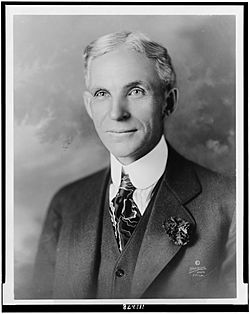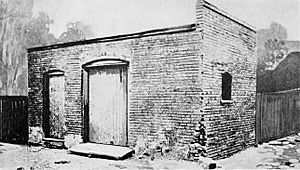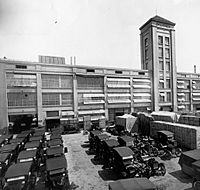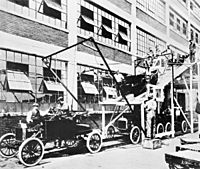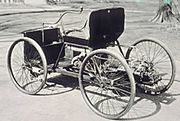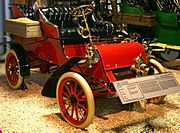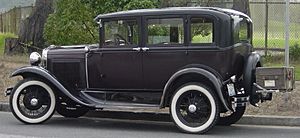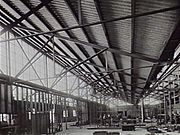History of Ford Motor Company facts for kids
Ford Motor Company is an American automaker and the world's fifth largest automaker based on worldwide vehicle sales. Based in Dearborn, Michigan, a suburb of Detroit, the automaker was founded by Henry Ford, on June 16, 1903. Ford Motor Company would go on to become one of the largest and most profitable companies in the world, as well as being one of the few to survive the Great Depression. The largest family-controlled company in the world, the Ford Motor Company has been in continuous family control for over 110 years. Ford now encompasses two brands: Ford and Lincoln. Ford once owned 5 other luxury brands: Volvo, Land Rover, Jaguar, Aston Martin and Mercury. Over time, those brands were sold to other companies and Mercury was discontinued.
Contents
Foundation
Henry Ford built his first automobile, which he called a quadricycle, at his home in Detroit in 1896. The location has been redeveloped, where the Michigan Building now stands, and the tracks for the Detroit People Mover and the Times Square People Mover station are nearby.
At the entrance to the Michigan Building, there is a commemorative plaque identifying the original location of the Ford home. The coal shed has been recreated using the original bricks at Greenfield Village in nearby Dearborn.
His initial foray into automobile manufacturing was the Detroit Automobile Company, founded in 1899. The company foundered, and in 1901 was reorganized as the Henry Ford Company. In March 1902, after falling out with his financial backers, Ford left the company with the rights to his name and 900 dollars.
Henry Ford turned to an acquaintance, coal dealer Alexander Y. Malcomson, to help finance another automobile company.
On June 16, 1903, the Ford Motor Company was incorporated, with 12 investors owning a total of 1000 shares.
Ford was subject to lawsuits or threats from the Association of Licensed Automobile Manufacturers early in its history. The Association claimed patent rights to most gasoline-powered automobiles. After several years of legal wrangling, the Association eventually dropped its case against Ford in 1911.
Early developments and assembly line
During its early years, the company produced a range of vehicles designated, chronologically, from the Ford Model A (1903) to the Model K and Model S (Ford's last right-hand steering model) of 1907.
The K, Ford's first six-cylinder model, was known as "the gentleman's roadster" and "the silent cyclone", and sold for US$2800; by contrast, around that time, the Enger 40 was priced at US$2000, the Colt Runabout US$1500, the high-volume Oldsmobile Runabout US$650, Western's Gale Model A US$500, and the Success hit the amazingly low US$250.
In 1908, Henry Ford introduced the Model T. The first Model Ts were built at the Piquette Avenue Plant and in the car's first full year of production, 1909, just over 10,000 Model Ts were built. As demand for the car grew, the company moved production to the much larger Highland Park Plant in 1910. In 1911, 69,762 Model Ts were produced, with 170,211 in 1912. By 1913, the company had developed all of the basic techniques of the assembly line and mass production.
Ford introduced the world's first moving assembly line that year, which reduced chassis assembly time from 12+1⁄2 hours in October to 2 hours 40 minutes (and ultimately 1 hour 33 minutes), and boosted annual output.
These innovations were hard on employees, and turnover of workers was very high, while increased productivity reduced labor demand. Turnover meant delays and extra costs of training, and use of slow workers. In January 1914, Ford solved the employee turnover problem by doubling pay to $5 a day cutting shifts from nine hours to an eight-hour day for a 5-day work week, and instituting hiring practices that identified the best workers, including disabled people considered unemployable by other firms. Employee turnover plunged, productivity soared, and with it, the cost per vehicle plummeted. Ford cut prices again and again and invented the system of franchised dealers who were loyal to his brand name.
While Ford attained international status in 1904 with the founding of Ford of Canada, it was in 1911 the company began to rapidly expand overseas, with the opening of assembly plants in Ireland (1917), England and France, followed by Denmark (1923), Germany (1925), Austria (1925), and Argentina (1925),. A factory was opened in Japan (1925) at Yokohama, and also in South Africa (1924) and Australia (1925) as subsidiaries of Ford of Canada due to preferential tariff rules for Commonwealth countries. By the end of 1919, Ford was producing 50 percent of all cars in the United States, and 40% of all British ones; by 1920, half of all cars in the U.S. were Model Ts. The assembly line transformed the industry; soon, companies without it risked bankruptcy. Of 200 U.S. car makers in 1920, only 17 were left in 1940.
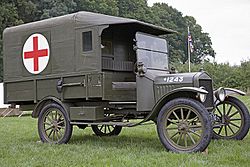
It also transformed technology. Henry Ford is reported to have said, "Any customer can have a car painted any color that he wants so long as it is black." Before the assembly line, Ts had been available in a variety of colors, including red, blue, and green, but not black. Now, paint had become a production bottleneck; only Japan Black dried quickly enough, and not until Duco lacquer appeared in 1926 would other colors reappear on the T.
In 1915, Henry Ford went on a peace mission to Europe aboard a ship, joining other pacifists in efforts to stop World War I. This led to an increase in his personal popularity. Ford would subsequently go on to support the war effort with the Model T becoming the underpinnings for Allied military vehicles, like the Ford 3-Ton M1918 tank, and the 1916 ambulance.
Post-World War I developments
Lincoln Motor Company
On February 4, 1922 Ford expanded its reach into the luxury auto market through its acquisition of the Lincoln Motor Company from Henry M. Leland who had founded and named the company in 1917 for Abraham Lincoln whom Henry Leland admired. The Mercury division was established later in 1938 to serve the mid-price auto market between the Ford and Lincoln brands.
Ford Motor Company dedicated the largest museum of American History in 1929, The Henry Ford. Henry Ford would go on to acquire Abraham Lincoln's chair, which he was assassinated in, from the owners of Ford's Theatre. Abraham Lincoln's chair would be displayed along with John F. Kennedy's Lincoln presidential limousine in the Henry Ford Museum & Greenfield Village in Dearborn, known today as The Henry Ford. Kennedy's limousine was leased to the White House by Ford.
The Great Depression
During the great depression, Ford in common with other manufacturers, responded to the collapse in motor sales by reducing the scale of their operations and laying off workers. By 1932, the unemployment rate in Detroit had risen to 30% with thousands of families facing real hardship. Although Ford did assist a small number of distressed families with loans and parcels of land to work, the majority of the thousands of unskilled workers who were laid off were left to cope on their own. However, Henry Ford angered many by making public statements that the unemployed should do more to find work for themselves.
This led to Detroit's Unemployed Council organizing the Ford Hunger March. On March 7, 1932 some 3,000 - 5,000 unemployed workers assembled in West Detroit to march on Ford's River Rouge plant to deliver a petition demanding more support. As the march moved up Miller Road and approached Gate 3 the protest turned ugly. The police fired tear gas into the crowd and fire trucks were used to soak the protesters with icy water. When the protesters responded by throwing rocks, the violence escalated rapidly and culminated in the police and plant security guards firing live rounds through the gates of the plant at the unarmed protesters. Four men were killed outright and a fifth died later in the hospital. Up to 60 more were seriously injured.
Soviet Fords and the Gorki
In May 1929 the Soviet Union signed an agreement with the Ford Motor Company. Under its terms, the Soviets agreed to purchase $13 million worth of automobiles and parts, while Ford agreed to give technical assistance until 1938 to construct an integrated automobile-manufacturing plant at Nizhny Novgorod.
Many American engineers and skilled auto workers moved to the Soviet Union to work on the plant and its production lines, which was named Gorkovsky Avtomobilny Zavod (GAZ), or Gorki Automotive Plant in 1932. A few American workers stayed on after the plant's completion, and eventually became victims of Stalin's Great Terror, either shot or exiled to Soviet gulags. In 1933, the Soviets completed construction on a production line for the Ford Model-A passenger car, called the GAZ-A, and a light truck, the GAZ-AA. Both these Ford models were immediately adopted for military use. By the late 1930s production at Gorki was 80,000-90,000 "Russian Ford" vehicles per year. With its original Ford-designed vehicles supplemented by imports and domestic copies of imported equipment, the Gorki operations eventually produced a range of automobiles, trucks, and military vehicles.
World War II
Era of neutrality
During the first 27 months of World War II, when the U.S. was neutral (to December 1941), Ford was hesitant to participate in the Allied military effort. Ford insisted that peaceful trade was the best way to avoid war. Ford had a subsidiary in Germany. In 1936, a Ford executive visiting Germany was informed by a Nazi official that Ford's Cologne plant manager was a Jew (he had one grandparent who was Jewish), prompting discussions at Ford offices in both Germany and the U.S. Heinrich Albert, Ford's Germany-U.S. liaison, insisted that the manager be fired. The manager was replaced by Robert Schmidt, who would play an important role in Germany's war effort.
Henry Ford had said war was a waste of time, and did not want to profit from it. He was concerned the Nazis during the 1930s might nationalize Ford factories in Germany. Ford nevertheless established a close collaboration with Germany's Nazi government before the war—so close, in fact, that Ford received, in July 1938, the Grand Cross of the German Eagle medal from the regime.
Ford's outspoken anti-semitism, including his newspaper, The Dearborn Independent, which published The Protocols of the Elders of Zion, also lent credence to the view that he sympathized with the Nazis. In the spring of 1939, the Nazi government assumed day-to-day control of many foreign-owned factories in Germany. However, Ford's Dearborn headquarters continued to maintain a 52% ownership over its German factories but with no voice or control or financial reward. Ford factories contributed significantly to the buildup of Germany's armed forces. Ford negotiated a resource-sharing agreement that allowed the German military to access scarce supplies, particularly rubber. During this same period, Ford was hesitant to participate in the Allied military effort. In June 1940, after France had fallen to the Wehrmacht, Henry Ford personally vetoed a plan to build airplane engines for the Allies.
Wartime
The company enthusiatically supported the war effort after Pearl Harbor, making it a major component of the "Arsenal of Democracy" that President Roosevelt had promised would mobilize industrial resources to win the war. Henry, aged 76 and early senile, played a minor role even though he had 55% ownership of the company stock. His son Edsel Ford, the company president and owner of 42% of the stock, had never been a pacifist like his father and now made all the decisions.
The company produced 390,000 tanks and trucks, 27,000 engines, 270,000 Jeeps, over 8000 B-24 Liberators, and hundreds of thousands of parts, gun mounts, and machine tools for the war effort. It ranked third among corporations in the value of wartime production contracts.
The Company's new Willow Run factory was designed for the production of B-24 bombers although the production line was initially characterized by bungling and incompetence. Ford's efforts benefited the Allies as well as the Axis. After Bantam invented the Jeep, the US War Department handed production over to Ford and Willys.
The Treasury Department investigated Ford for alleged collaboration with German-run Ford plants in occupied France, but did not find conclusive evidence. After the war, Schmidt and other Nazi-era managers kept their jobs with Ford's German division. In the United Kingdom, Ford built a new factory in Trafford Park, Manchester during WWII where over 34,000 Rolls-Royce Merlin aero engines were completed by a workforce trained from scratch.
Post-World War II developments
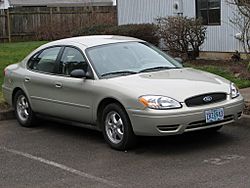
In 1943, a despondent Edsel Ford died of stomach cancer. Henry decided then to resume direct control of the company, but this proved a very poor idea as he was 78 years old and suffering from heart problems and atherosclerosis. His mental state was also questionable, and there was a very real possibility that the company would collapse if he died or became incapacitated. The Roosevelt Administration had a contingency plan in place to nationalize Ford if need be so that they wouldn't lose vital military production.
At this point, Ford's wife and daughter-in-law intervened and demanded that he turn control over to his grandson Henry Ford II. They threatened to sell off their stock (amounting to half the company's total shares) if he refused. Henry was infuriated, but there was nothing he could do, and so he gave in. When Henry II, who came to be called affectionately "Hank the Deuce," assumed command, the Company was losing US$9 million a month and in financial chaos.
Henry Ford died of a brain hemorrhage on April 7, 1947. Mourners passed by at a rate of 5,000 each hour at the public viewing on Wednesday of that week at Greenfield Village in Dearborn. The funeral service for Henry Ford was held at the Cathedral Church of St. Paul in Detroit on Thursday April 9, 1947. At the funeral service, 20,000 people stood outside St. Paul's Cathedral in the rain with 600 inside, while the funeral had attracted national attention as an estimated seven million people had mourned his death (according to A&E Biography).
Ernest R. Breech, head of Bendix Aviation, was hired in 1946, and became first Executive Vice President, then Board Chairman in 1955. Henry II served as President from 1945 to 1960, and as Chairman and CEO from 1960 to 1980. In 1956, Ford became a publicly traded corporation. The Ford family maintains about 40% controlling interest in the company, through a series of Special Class B preferred stocks. Also in 1956, following its emphasis on safety improvements in new models, Motor Trend awarded the company its "Car of the Year" award.
Ford introduced the iconic Thunderbird in 1955 and the Edsel brand automobile line in 1958, following a US$250 million research and marketing campaign, which had failed to ask questions crucial for the marque's success. The Edsel was cancelled after less than 27 months in the marketplace in November 1960. The corporation bounced back from the failure of the Edsel by introducing its compact Falcon in 1960 and the Mustang in 1964. By 1967, Ford of Europe was established.
Lee Iacocca was involved with the design of several successful Ford automobiles, most notably the Mustang. He was also the "moving force," as one court put it, behind the notorious Pinto.
In 1942, Elsa Iwanowa, who was then 16 years old and a resident of Rostov in the Soviet Union, and many other citizens of countries that were occupied by the Wehrmacht were transported in cattle cars to the western part of Germany, where they were displayed to visiting businessmen. From there Iwanowa and others were forced to become slave laborers for Ford's German subsidiary, which had become separated from the Dearborn headquarters as a result of the U.S. declaration of war
"On March 4, 1998, fifty-three years after she was liberated from the German Ford plant, Elsa Iwanowa demanded justice, filing a class-action lawsuit in U.S. District Court against the Ford Motor Company." In court, Ford admitted that Iwanowa and many others like her were "forced to endure a sad and terrible experience"; Ford, however, moved to have the suit dismissed on the grounds that it would be best redressed on "a nation-to-nation, government-to-government" basis. In 1999, the court dismissed Iwanowa's suit. At about the same time, a number of German companies, including GM subsidiary Opel, agreed to contribute $5.1 billion to a fund to compensate the surviving slave laborers. After being the subject of much adverse publicity, Ford, in March 2000, agreed to contribute $13 million to the compensation fund.
General corporate timeline
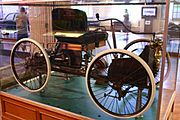

- 1896: Henry Ford builds his first vehicle – the Quadricycle – on a buggy frame with 4 bicycle wheels.
- 1898: Ford creates the Detroit Automobile Company; two and a half years later it is dissolved.
- 1901: Ford wins high-profile car race in Grosse Pointe, Mi
- 1901: The Henry Ford Company is incorporated but discontinued the following year only to be reinvigorated by Henry Leland as the Cadillac Motor Company
- 1903: Ford Motor Company incorporated with 11 original investors. The Model A "Fordmobile" is introduced - 1,708 cars are produced.
- 1904: Ford Motor Company of Canada incorporated in Walkerville, Ontario
- 1904: Henry Ford teams up with Harvey Firestone of Firestone Tires
- 1906: Ford becomes the top selling brand in the US, with 8,729 cars produced.
- 1908: Model T is introduced. 15 million are produced through 1927.
- 1909: Ford Motor Company (England) established, otherwise referred to as Ford of Britain
- 1911: Ford opens first factory outside North America – in Manchester, England.
- 1913: The moving assembly line is introduced at Highland Park assembly plant, making Model T production 8 times faster.
- 1913: Ford opens second world branch in Argentina as Ford Motor Argentina
- 1914: Ford introduces $5 ($146, adjusted for inflation) wage for a workday – double the existing rate.
- 1918: Construction of the Rouge assembly complex begins.
- 1919: Edsel Ford succeeds Henry as Company President.
- 1920: Ford temporarily shuts down due to low sales. After removing unnecessary administrative expenses and waste, Ford reopens.
- 1921: Ford production exceeds 1 million cars per year, nearly 10 times more than Chevrolet - the next biggest selling brand.
- 1922: Ford purchases Lincoln Motor Company for US $8 million ($140 million, adjusted for inflation).
- 1925: Ford introduces Ford Tri-Motor airplane for airline services, and a factory was built in Yokohama, Japan in February.
- 1926: Ford Australia is founded in Geelong, Victoria, Australia,
- 1927: Model T production ends, Ford introduces the next generation Model A, from the Rouge complex.
- 1929: Ford regains production crown, with annual production peaking at 1.5 million cars
- 1931: Ford and Chevy brands begin to alternate as U.S. production leaders, in battle for automobile sales during the Great Depression.
- 1932: Ford introduces the one-piece cast V8 block. It makes the Model 18 the first low-priced V8-powered car. In London Royal Albert Hall the Model 19, or as it was marketed Model Y, are introduced February 19. The first of a long line of small European Fords.
- 1936: Lincoln-Zephyr is introduced.
- 1938: The German consul at Cleveland awards Henry Ford the Grand Cross of the German Eagle, the highest medal Nazi Germany could bestow on a foreigner. There is some evidence Ford had Nazi sympathies, at least before World War II. He may have financed some Nazi activities, and was active in anti-semitic efforts.
- 1939: Mercury division is formed to fill the gap between economical Fords and luxury Lincolns. Operated as a division at Ford until 1945
- 1941: The Lincoln Continental is introduced. Ford begins building general-purpose "jeep" for the military. First labor agreement with UAW-CIO covers North American employees.
- 1942: Production of civilian vehicles halted, diverting factory capacity to producing B-24 Liberator bombers, tanks, and other products for the war effort.
- 1943: Edsel Ford dies of cancer at the age of 49, Henry Ford resumes presidency.
- 1945: Henry Ford II becomes president.
- 1945: Lincoln and Mercury are combined into a single division.
- 1946: Ford sues the allies for damages done to his factories in Dresden during the infamous bombing, and wins compensation.
- 1946: The Whiz Kids, former US Army Air Force officers, are hired to revitalize the company. Automobile production resumes.
- 1947: Henry Ford dies of cerebral hemorrhage at the age of 83; Henry Ford II becomes new chairman.
- 1948: F-1 Truck introduced. Lincoln Continental is introduced.
- 1949: The '49 Ford introduces all-new post-war era cars. The "Woody" station wagon is introduced.
- 1953 Ford Canada Headquarters and Car Plant opens in Oakville, Ontario
- 1954: Thunderbird introduced as a personal luxury car with a V8. Ford begins crash testing, and opens Arizona Proving Grounds.
- 1956: Ford World Headquarters dedicated, September 26, 1956
- 1956: $10,000 ($109 thousand, adjusted for inflation) Lincoln Continental Mark II introduced. Ford goes public with common stock shares. Ford's emphasis on safety with its Lifeguard option package, including seat belts and dash padding, earns the company Motor Trend's "Car of the Year" award.
- 1957: Ford launches the Edsel brand of automobiles in the fall of 1957 as 1958 models. Ford is top selling brand, with 1.68 million automobiles produced.
- 1959: Ford Credit Corporation formed to provide automotive financing.
- 1959: Ford withdraws the 1960 model Edsels from the market in November 1959.
- 1960: Ford Galaxie and compact Ford Falcon introduced.
- 1960: Robert McNamara is appointed President of Ford by Chairman Henry Ford II.
- 1960: Ford President Robert McNamara appointed Secretary of Defense by President elect John F. Kennedy.
- 1962: Ford of Britain launches first generation of the Ford Cortina. It would dominate the mid-size family segment in Europe for the next 20 years.
- 1964: Ford Mustang the car that started the "pony car" class, Ford GT40 challenges Ferrari and Porsche at LeMans.
- 1965: Ford brand US sales exceed 2 million units. Ford of Germany and Ford of Britain jointly launch the first generation Ford Transit range of panel vans.
- 1965: Ford Galaxie 500 LTD debuts, advertised as quieter than a Rolls Royce
- 1966: Ford Bronco sport utility vehicle introduced.
- 1967: Ford of Europe is established by merging the operations of Ford of Britain and Ford of Germany.
- 1967: Ford opens Talbotville car plant in St. Thomas, Ontario
- 1968: Lincoln Mark Series is introduced as the company's first personal luxury car to compete with the Cadillac Eldorado. Ford of Europe launches first generation Ford Escort.
- 1970: Ford Maverick are introduced. Ford establishes Asia Pacific operations. Ford of Europe launches the third generation Cortina/Taunus - merging the two previously independent product lines under a common platform.
- 1972: Retractable seat belts introduced.
- 1973: Ford US brand sales reaches an all-time high of 2.35 million vehicles produced.
- 1974: Ford Mustang II debuts as a smaller more economical pony car.
- 1975: Ford Granada and Mercury Monarch introduced, Maverick continues
- 1975: Ford of Europe launches the second generation Escort.
- 1976: Ford of Europe launches the first generation Ford Fiesta
- 1977: Ford of Europe launches the fourth generation Cortina/Taunus
- 1978: Ford Motor Company celebrates 75th anniversary. Continental Mark V and Thunderbird available with "Diamond Jubilee Edition" packages. Fiesta is imported from Europe as an entry into the economy segment.
- 1979: Ford acquires 25% stake in Mazda. Ford becomes the final American automaker to introduce downsized full-size cars with radically smaller Panther platform.
- 1980: Ford of Europe launches the third generation Escort, it is voted European Car of the Year for 1981.
- 1981: The Lincoln Town Car and Ford Escort are introduced. Fiesta discontinued in North America.
- 1982: Ford of Europe introduce the Ford Sierra, ending production of the stalwart Cortina/Taunus after 20 years and four generations.
- 1983: Ford launches a redesigned "aero design" Thunderbird. In a model shift, the Granada is discontinued in North America, replaced by a facelifted model re-branded as the LTD. All full-size models are now LTD Crown Victorias/Country Squires.
- 1984: Ford Tempo and Mercury Topaz are introduced, replacing the Ford Fairmont/Mercury Zephyr.
- 1985: Ford Scorpio launched by Ford of Europe. Replaces Granada as its full-size offering and is voted European Car of the Year for 1986, Ford's second COTY win in the 1980s. Merkur brand launched to market the Sierra and Scorpio models in North America.
- 1985: Purchases First Nationwide Financial Corporation, a savings and loan. Sold in 1994 after large losses.
- 1985: Ford Taurus introduced with dramatic "aero design" styling, along with Ford Aerostar minivan.
- 1986: Ford of Europe launches the second generation of the Transit van family. Ford Capri ceases production.
- 1987: Ford acquires Aston Martin Lagonda and Hertz Rent-a-Car.
- 1987: Henry Ford II dies at age 70.
- 1988: Ford Festiva, built in Korea by Kia is introduced.
- 1989: Ford acquires Jaguar. Mazda MX-5 Miata is unveiled. Third generation Fiesta is launched in Europe - and establishes itself as the fastest selling generation of Fiesta to date - 1 million units in less than two years.
- 1989: Acquires Associates First Capital Corporation, a finance company. In 1998, it is spun off to Ford shareholders.
- 1990: Ford Aerostar is Motor Trend's Truck Of The Year, while Lincoln Town Car is Motor Trend's Car Of The Year.
- 1990: Merkur brand of automobiles production discontinued. Ford of Europe launches fourth generation Escort.
- 1991: Ford Explorer is introduced, turning the traditionally rural and recreational SUV into a popular family vehicle.
- 1992: Ford Aerostar and Ford Taurus/Mercury Sable are redesigned; Ford Taurus becomes America's top selling car, displacing the Honda Accord. Ford of Europe announces first generation Ford Mondeo, the first product of the global CDW27 platform
- 1992: Redesigned Ford Crown Victoria and Mercury Grand Marquis launched, the first new full-size sedans in 13 years; Ford Country Squire/Mercury Colony Park station wagon discontinued.
- 1993: Ford launches Mondeo in Europe, and announces its North American derivatives - the Ford Contour and Mercury Mystique
- 1994: Ford Tempo and Mercury Topaz are discontinued - replaced by Ford Contour and Mercury Mystique* 1994: Ford Aspire replaces Festiva, becoming the first car in its class to offer standard dual air bags and optional 4-wheel ABS.
- 1995: Ford's first front-wheel-drive V8 sedan is introduced, the 4.6L V8-powered Lincoln Continental. Ford of Europe launches fourth-generation Fiesta.
- 1995: New front-wheel-drive Ford Windstar minivan is introduced. Aerostar remains in production. Redesigned Ford Explorer released, now with standard safety features such as dual air bags, 4-wheel ABS as standard equipment.
- 1996: Ford certifies all plants in 26 countries to ISO 9000 quality and ISO 14001 environmental standards. The V12-powered Jaguar XJS is discontinued.
- 1996: Controversially redesigned "Ovoid" Ford Taurus and Mercury Sable are introduced. Exit of Chevrolet Caprice leaves full size fleet market to Ford Crown Victoria.
- 1996: Ford increases investment stake in a troubled Mazda Corporation to a controlling interest of 33.4%.
- 1997: Full size 4-door SUV Ford Expedition introduced replace the Ford Bronco.Mercury Mountaineer introduced. Redesigned Ford Escort and Mercury Tracer also introduced.
- 1997: Ford Aerostar production ends, along with Ford Probe, Ford Thunderbird, Mercury Cougar, Mazda MX-6, and Ford Aspire, without immediate replacement.
- 1997: Sculpted redesign of Ford's top-selling F-150 pickup, overcomes controversy to set sales records.
- 1998: Lincoln Navigator creates domestic luxury SUV class. Mark VIII is in its final year, introduces HID-headlamps, midway through model year 1996.
- 1998: The Focus replaces the ageing Escort in Europe and quickly becomes one of the best-selling cars of the segment. Is launched in North America for the 2000 model year.
- 1999: Ford acquires Volvo car division from Volvo. Bill Ford becomes Chairman of the Board, replacing Jacques Nasser.
- 1999: A smaller sporty Mercury Cougar is reintroduced with front-wheel drive.
- 1999: Jaguar Racing Formula One team is formed, with Jackie Stewart at the helm.
- 1999: Ford splits its full-sized pick-ups into two distinct models (the first to do so) with the introduction of the Ford F-Series Super Duty (F-250 - F-550). Ford Excursion (based on Super Duty) is introduced, and has the distinction of being the largest SUV sold anywhere.
- 2000: Ford purchases Land Rover brand from BMW. Lincoln LS and Jaguar S-Type are introduced, along with a refreshed Ford Taurus and Mercury Sable. The Lincoln LS becomes the 2000 Motor Trend Car of the Year. Escort is discontinued in Europe. Third generation Transit platform is launched in Europe.
- 2001: Retro-styled Ford Thunderbird is introduced, based on the Lincoln LS/Jaguar S-Type DEW98 platform, and is also named Motor Trend Car of the Year for 2002.
- 2002: Fifth-generation Fiesta is launched by Ford of Europe.
- 2002: Lincoln Continental is discontinued after a roughly fifty-year run. Jaguar X-Type is introduced (first AWD Jaguar). Escort van production ends in Europe, marking the end of the Escort name after a 24-year production run. Ford Transit Connect production begins at Ford-Otosan in Turkey.
- 2003: Ford Motor Company's 100th Anniversary. The Ford GT is released, along with limited Centennial editions of some Ford vehicles.
- 2004: Jaguar Racing team sold to Red Bull GmbH. Ranger sales decline, losing the title as top-selling compact pickup. The similar Mazda B-series pickup is withdrawn from the US market. The Ford Escape Hybrid, the first gasoline-electric hybrid SUV, is introduced. Major redesign of the Ford F-150 and introduction of the Lincoln Mark LT. Ford Freestar and Mercury Monterey minivans are introduced, replacing the Ford Windstar and Mercury Villager.
- 2005: Ford Mustang redesigned with retro styling reminiscent of the 1960s models. The Ford Five Hundred, Mercury Montego, and Ford Freestyle are introduced. Mercury Sable production ends, and Ford Taurus production is limited to rental car, taxi, and other fleet sales.
- 2006: Ford Taurus ends production after a 20-year run. Ford Fusion, Mercury Milan, and Lincoln Zephyr introduced. Ford announces major restructuring program The Way Forward, which includes plans to shut unprofitable factories. Bill Ford steps down as CEO, remains as Executive Chairman. Alan Mulally elected President and CEO. Ford Freestar and Mercury Monterey minivans are discontinued without replacement. Ford mortgages all assets to raise $23.4 billion cash in secured credit lines, in order to finance product development during restructuring through 2009. According to J. D. Power and Associates quality surveys, the Ford Fusion is rated higher in quality than its chief rivals, the Toyota Camry and Honda Accord.
- 2007: Ford sells Aston Martin to a British consortium led by Prodrive chairman David Richards, and announces plans to sell Jaguar and Land Rover.
- 2007: Ford reports losses of $12.7 billion for 2006. Ford Edge and Lincoln MKX introduced. The Lincoln Zephyr is replaced with the Lincoln MKZ. A redesigned Ford Expedition (including the longer wheelbase "EL" version) and Lincoln Navigator are introduced. Ford unveils the Ford Interceptor and Lincoln MKR concept cars, and a pre-production Lincoln MKS is introduced. The Ford Five Hundred, Ford Freestyle and Mercury Montego nameplates are dropped and replaced with the previously retired Ford Taurus, Ford Taurus X, and Mercury Sable nameplates.
- 2008: Ford sells Jaguar and Land Rover to Tata Motors.
- 2008: Ford of Europe launches sixth-generation Fiesta, based on the Verve concept car. and announces plans to sell Jaguar and Land Rover.
- Sources:
- General Timeline (through 2002): Ford Motor Company 2002 Annual Report
- Production figures: U.S. Automobile Production Figures
- 2009 Ford announces that it will leverage more of its European line-up for the North American market. The Turkish-built Transit Connect compact panel van is the first exponent of this strategy, followed by the sixth-generation Ford Fiesta subcompact.
- 2010 Ford sells Volvo Cars to Geely Automobile. Third generation Ford Focus unveilied - as with the first generation car, it will return to using a single platform for all markets - will be released in North America as a 2012 model.
- 2011: Mercury production ends; the last vehicle is a Grand Marquis. Lincoln Town Car is discontinued. Ford Focus Electric unveiled. Ford announces that they will sell 8 million vehicles globally by 2015.
- 2011: Ford Ranger discontinued for North America; redesigned global version launched.
- 2012: Fourth generation Mondeo/Fusion previewed at the Detroit Motor Show, thus reuniting Ford's mid-size platform for Europe and North America for the first time since the CDW27 1st gen Mondeo/Contour/Mystique of 1994. Ford Crown Victoria, sold only for export in 2012, is discontinued.
- 2013: Fourth generation Transit/Tourneo launched, along with the second generation Transit Connect and the refreshed Fiesta is revealed.
- 2014: The Ford Mustang celebrates 50 years of production with the launch of its sixth generation. The 2015 F-150 is launched, featuring an aluminum-intensive body design.
Images for kids
-
Former Ford CEO Alan Mulally, who was hired by William Clay Ford, Jr. to restructure the company


